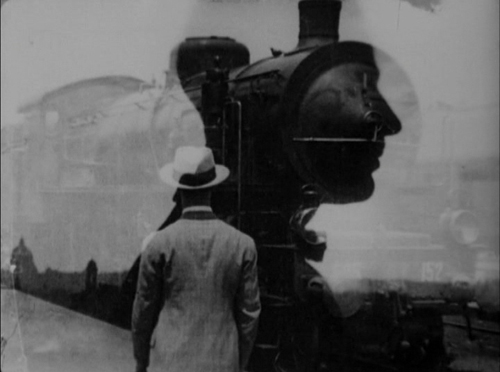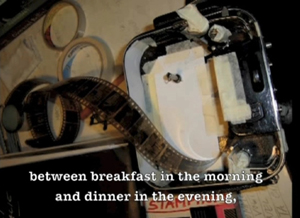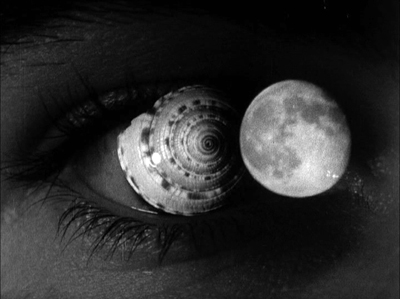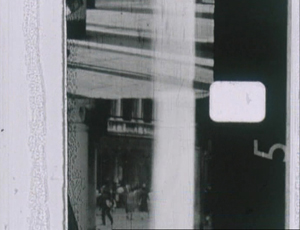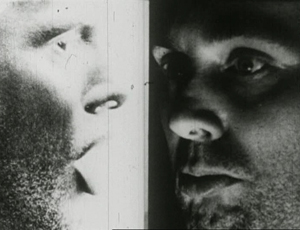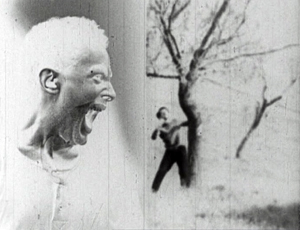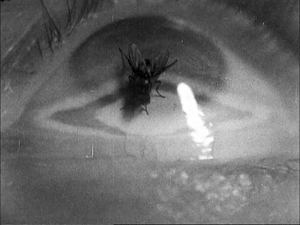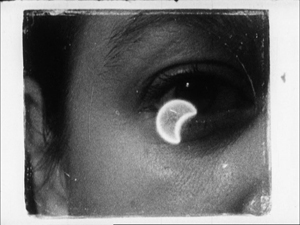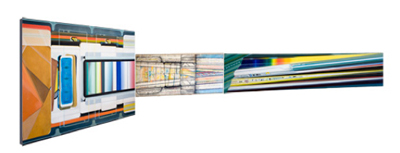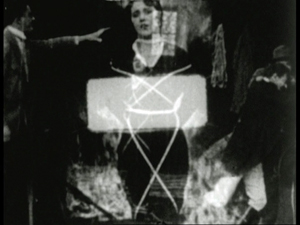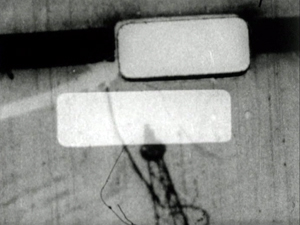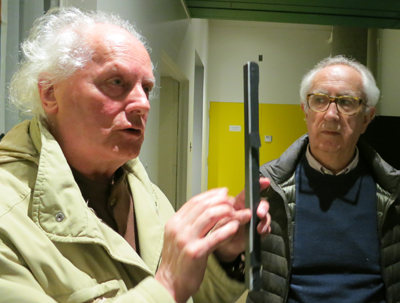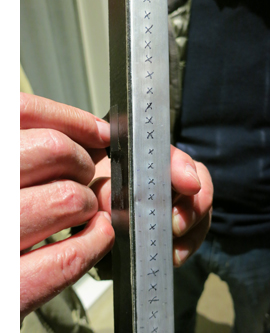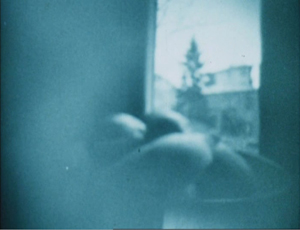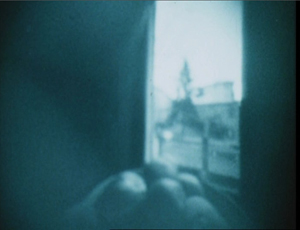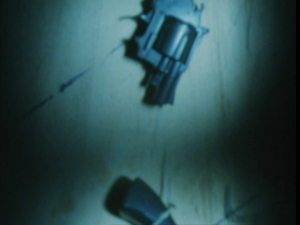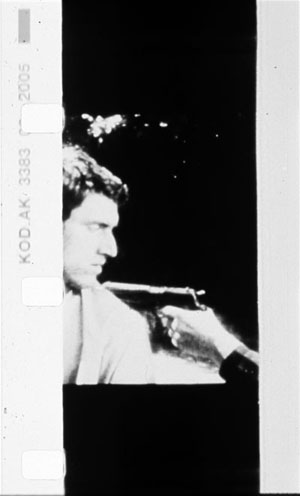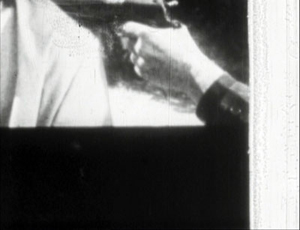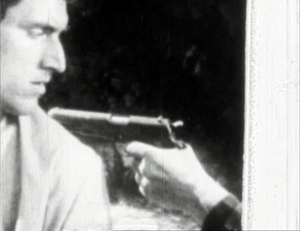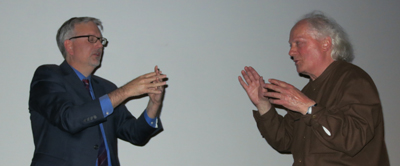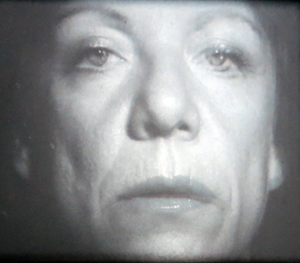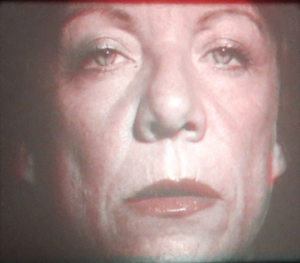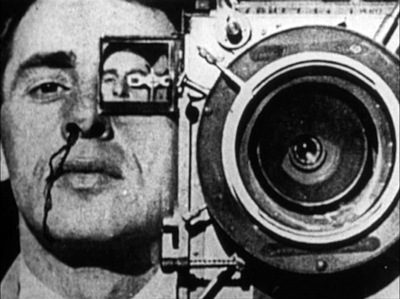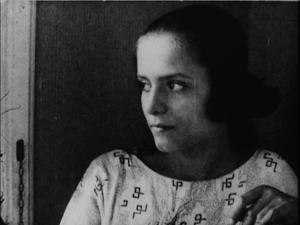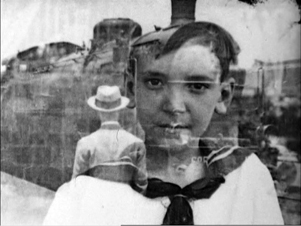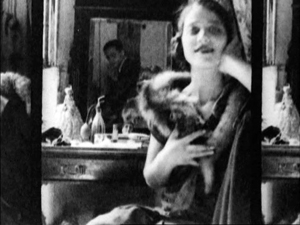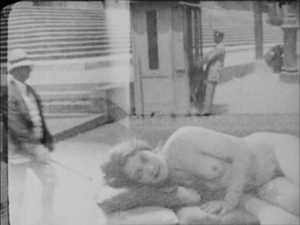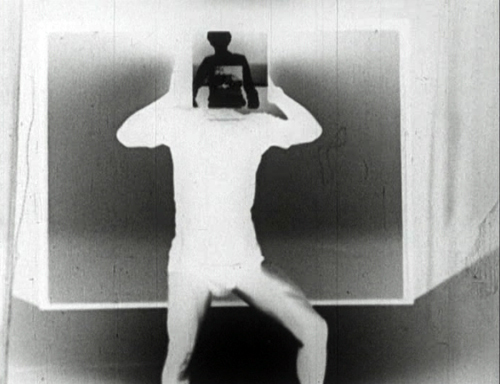Paolo Gioli, maximal minimalist
Tuesday | April 19, 2016 open printable version
open printable version
Anonymatograph (1972).
DB here:
Since the late 1960s, the Italian filmmaker Paolo Gioli has been employing procedures that are almost frighteningly stripped down. He has made films without cameras. He has devised his own cameras, often without lenses or shutters or motor drives. When he needs a shutter, his fingers, or perhaps some leaves from trees, will suffice. He has embedded images within images without benefit of optical printers, and he has brought photos to frenetic life without animation stands. When he needs a camera, a modest old Bolex or Bell & Howell will do fine. Impresario of clamps and masking tape, he creates extraordinary films with equipment that looks distinctly knocked-together.
The overused term DIY doesn’t capture the eccentric craftsmanship of a filmmaker who starts from the most basic features of cinematic material: film stock, perforations, light. Everything else, even the frame, can be treated as an add-on. These films are hand-made with a vengeance.
Sparse as the equipment and approach are, the results are overwhelming. Gioli’s films can be quietly lyrical or explosively aggressive. Most are fairly compact—fifteen minutes or less—but all are dauntingly dense. Each one’s fusillade of images would be enough for a feature. Skittering and jumpy, emitting a spray of single frames, the most fast-moving ones benefit from being black-and-white and silent: nothing distracts from the swarming images’ direct hit on your eye and brain.
Last weekend, the Harvard Film Archive hosted an event honoring Gioli, his long-time producer Paolo Vampa, and my Wisconsin colleague Patrick Rumble, a tireless advocate for Gioli’s cinema. Head archivist Haden Guest, another long-time supporter of Gioli’s work, timed the gathering with the release of Gioli’s collected works in a three-DVD set from Raro. That collection is a must for anyone interested in experimental cinema. Along with the films it includes Patrick’s seminal essay, “Free Films Made Freely,” and his superb documentary on Gioli’s life and working methods.
I was lucky enough to be present too, thanks to the accident of my having written a little on Gioli way back when. I think it’s fair to say that a hell of a time was had by all—not least because seeing a rich sampling of the work on the Archive’s magnificent big screen made these films, at once rough-edged and precise, even more powerful than when they’re seen on a monitor.
Back to basics–real basics
When the Eye Quakes (1991).
There’s no easy way to sum up the great variety of these films, but I owe you a sense of what they’re like. Start with the ones based on the physical stuff of the medium.
Gioli began as a painter and became both a photographer and filmmaker. He came to cinema as a result of his youthful stay in New York, where he encountered the New American Cinema. It’s not hard to see an overlap with filmmakers like George Landow (Owen Land), Ken Jacobs, and others whose films were based on displaying grain, scratches, perforations, and other physical properties of the medium. But instead of the Cagean repetition of Landow’s Film in Which There Appear Edge Lettering, Sprocket Holes, Dirt Particles, Etc. (1966), Gioli’s Commutations with Mutation (1969) bombards us with weaving, sliding, rolling strips of film (Super-8, 16, 35), all yoked violently together.
Already one sees a major motif of Gioli’s work, the frame-within-the-frame. The sprocket holes become miniature versions of the frame that can’t contain the agitation of the film stuff spilling across it.
When the film gets more representational, as in According to My Glass Eye (1971), the split screen still suggests two or more films crammed into the same frame. Human faces and figures are wrenched into obsessive symmetries, mirrorings, and embeddings.
The pounding oscillation of this film, made of hundreds of different frames, is unremitting. It’s a sort of anti-Muybridge experiment: instead of decomposing action into bits, the fragments are whipped into a frenzy. The motion is insanely fast, with bodies surging in convulsions as eyes roll and pop terrifyingly. Most Gioli films are silent, but here the aggression is accentuated by driving drum rhythms.
The same primal thrust comes from When the Eye Quakes (1991), one of Gioli’s found-footage efforts. Starting from the woman’s slit eye at the beginning of Buñuel’s Andalusian Dog (1929), we get a sort of pictorial cadenza. Bunuel’s original metaphorically linked eye to moon, cloud to a razor slicing it. In Gioli’s remake, a fly crawls on the eye, the eye is peeled open to reveal a flurry of abstract patterns inside, the gash is stitched shut, and the whole array triggers REMs in another pair of eyes.
The agreeably assaultive side of Gioli’s work finds an emblem in his painting Superficie vasta della sorgente (1970). Here a rectangle serves as the screen, and two trapezoidal paintings mimic the projector beam.
The whole ensemble suggests not only a projector sending images to a support but a torrent of images pumped out to punch the viewer.
A more leisurely found-footage film is The Perforated Cameraman (1979), which stops and restarts shots from a silent comedy. Those images are haunted by yet another variant of the frame: wide-angle rectangles drifting in and out.
One such shape turns out to be a ghostly version of the center perforation of the 9.5mm format. That’s the format of the source movie itself, which is, in another reflexive twist, about the making of a movie.
Optics, mechanics
Paolo Gioli demonstrates one of his pinhole cameras as Paolo Vampa looks on.
Gioli has said that he wants to free himself from cinema’s reliance on “optics and mechanics.” Accordingly, he has reverse-engineered, or rather de-engineered, the apparatus of image-making. Take his various experiments with pinhole imagery. He has pushed the idea of the pinhole photograph (of which he has made many) to another level with pinhole movies.
He started with buttons, using their holes as light-gathering apertures. But since a shirt’s buttons are arranged top to bottom, why not do the same with pinholes? Accordingly, he devised a tube punctured at regular intervals, like a flute. The tube has a chamber for a film strip, with one pinhole per frame. The “shutter” is a hinged strip of metal that opens and shuts to expose the film.
To make the shot the “camera” is held upright. What’s hard to get your mind around is that the frames aren’t exposed sequentially, but all at once. They present varying angles on the subject at one instant.
When developed and run through a projector, however, they gain a temporal dimension. The footage presents an object that seems to slide vertically into view, framed by serrated edges and illuminated by irregular flares of light. Because the first images we see in a shot are those at the bottom of the tube, we may get the effect of a rising camera movement, when in fact there was none. A bowl of fruit in the foreground sinks out of sight as we seem to withdraw from a window.
Each tubular camera yields “takes” of more or less constant length; one tube is two meters long, another is only about 50 frames. Assembled (usually in camera rather than in postproduction), the shots arrive in a regular rhythm. Sometimes the footage displays another in-camera montage: Gioli has cut the hinged strip into two parts, so that he’s able to expose the top part of the film in taking one “shot,” then, separately, another strip of frames at the bottom. And sometimes the upper edge of the motif is cropped and it creeps in from the bottom.
The rigid verticality of Film Stenopeico (aka The Man without a Movie Camera, 1973/1981/1989) and Natura Obscura (2013) seems to me another version of the way in which Commutations with Mutation created one long image on the film strip and then chopped it into bits in projection. What has no framelines acquires them during the screening.
In an essay posted on this site, I noted that these efforts toward a “vertical” cinema recalled Eisenstein’s call to repudiate the horizontality of the classic 4:3 frame. It’s also worth remarking that once you know how the pinhole films are made, you’re obliged to think of each film as having two modes of existence: the physical object threaded through the perforated cylinder, and the film as we see it, an upward scan of an object in our surroundings.
Seeing red
Patrick Rumble and Paolo Gioli explain the experiment Land’s Red (2014).
This “double film,” the duality of the physical and the perceptual in our experience of the movies, is there at the start of his career. On the screen, Traces of Traces (1969) vibrates with abstract patterns of contours, edges, and whorls; it takes on a different sense when you learn that Gioli made it by pressing fingers, sandpaper, rubber stamps, and body surfaces against the film stock. As ever with avant-garde cinema, the question What am I seeing? often comes down to How were these images made?
Gioli’s “new optics” makes him interested in perceptual phenomena like visual saccades (exaggerated to a terrifying degree by his frenetic fast motion) and color vision. Fascinated by the oddities of our visual system, he has “operationalized” Edwin Land’s early experiments in color perception. In an important 1959 article, Land considered the sources of color constancy—the fact that an orange looks about as orange in bright sunlight as it does in deep shade. Yet the lighting conditions are drastically different and should yield a different color sensation. Somehow our visual system “knows” to adjust for fluctuating illumination and yields a stable color world.
Land’s experiment filmed black-and-white still photographs through color filters, then displayed them as slides and tinted the projection beams. He discovered that under certain conditions, we can recover a wide range of colors from a combination of pure white light and a red filter. It’s as if our visual system, which is sensitive to three overlapping wavelengths of light, was endowed by evolution with a bit of redundancy. Moreover, color constancy suggests that perception of color is independent of degrees of illumination.
Gioli replicated Land’s experiment with motion pictures by creating black-and-white film loops (Land’s Red, 2014). During his Harvard Film Archive stay, he demonstrated the result, including a close-up shot of a woman with blue eyes and bluish-silver eye shadow. The left image is the double-projection without a filter, the right is the image with a red filter. We’d expect that putting the filter on tints the entire image red. Instead, the filter generates a range of color, from the vibrant lips to the pale blue of the eyes and eye shadow.
Land’s theory involves psychophysical matters I can’t claim to understand. I gather that his account of three wavelengths in our cones’ pigments is now seen as a partial explanation of color vision. His “retinex” theory—the idea that the retina isn’t the only source of color, that there must be coding of the wavelengths in the cerebral cortex too—pointed other researchers toward a computational account of perception. The eye is a part of the mind.
Gioli’s startling demonstration reminds us that experimental science and “experimental” cinema aren’t always so far apart. A lot of avant-garde films, such as those of Ken Jacobs (discussed a bit herabouts) constitute rich, poetic probes into the quirks of our vision.
A past remade
Gioli has quickened photographs through pixillation, creating movement out of stills with an almost childish simplicity. He just snaps frames from illustrated books. Filmarilyn (1992) uses images from a Bert Stern collection to evoke Marilyn Monroe’s flirtation with death. Perhaps Gioli’s most accessible film, Children (2008) is a succinct, somewhat mordant reflection that carries us from Avedon shots of John and Jackie Kennedy, romping with Caroline and John, Jr., to images from Jacob Riis’ investigation of poverty in New York, and then to the imagery of the My Lai massacre.
Gioli has also done a kind of archeology of early film, as in his homage to chronophotography Little Decomposed Film (1986). My own favorite of his works is the lyrical and melancholy Anonymatograph (1972). In some ways it’s parallel to the work of “Structural” filmmakers like Malcolm Le Grice (e.g., Little Dog for Roger, 1966). The principal source is 35mm material of 1910-1930s from an unknown cameraman. The anonymous photographer recorded families and street scenes, both posed figures and spontaneous laughs and yawns. The footage was shot on an unusual Zeiss camera that could take both still images and motion pictures (a machine ideally made for Gioli).
Gioli’s reworking is typically high-strung, with nearly single-frame imagery at various points. Yet it doesn’t seem jittery. Despite the pace, the film proceeds majestically. It’s at once celebratory, showing gorgeous people, grave or gay, turning to or from the camera, and mournful, as the progression of shots takes us toward war and fascism. There are glimpses of “folk porn,” and hallucinatory superimpositions recalling juxtapositions out of Magritte or Paul Delvaux.
Gioli endows these long-dead divas and sturdy gentlemen with graceful, almost tragic unawareness of their place in history. Anonymatograph goes beyond his pure experiments with light, shape, and the skin of the film. It’s a testimony to the subtle power of old pictures and to an artist’s ability to reimagine, without abandoning any of his nervous intensity, the world they captured. No wonder Patrick Rumble calls Gioli “the last of the first filmmakers.”
I haven’t dealt with the full range of Gioli’s work. I’ve neglected the paintings and photographs, and I’ve had to neglect his powerful “photofinish” films (e.g., Slit-scan Figures, 2009). I just hope I’ve intrigued you enough to induce you to explore this unique and unpredictable filmmaker.
Thanks to Haden Guest for inviting me to participate in the HFA event, to Jeremy Rossen for help during my visit, to Patrick Rumble for many discussions of the films, to John Powers of Madison for information about optical printing, and of course to Paolo Vampa and Paolo Gioli for sharing ideas and information.
The Gioli collection is distributed in the US by the far-sighted company Kino Lorber. There’s also a book of essays, Paolo Gioli: The Man without a Movie Camera, ed. Alessandro Bordina and Antonio Somaini (Mimesis, 2014). The official Paolo Gioli website is here.
The Edwin Land articles are “Experiments in Color Vision,” Scientific American (May 1959), 84-99. and “The Retinex Theory of Color Vision,” Scientific American (December 1977), 108-128. A good biography of this remarkable man is Victor K. McElheny, Insisting on the Impossible: The Life of Edwin Land (New York: Basic, 1999).












